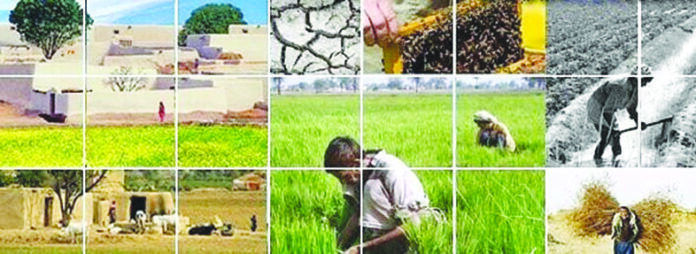It is an irony that the sector which provides a livelihood to more than 40 percent of the workforce of the country is so neglected. The contribution of agriculture is brushed aside by quoting just 22-23 percent as its contribution to GDP. Regardless of the debate on the authenticity of the figures, this percentage of 22-23 percent cannot be seen in isolation as agriculture provides inputs to various other sectors like manufacturing, transport, storage, and wholesale and retail trade, among others. A country’s economy is just like a book. It has to be read and analyzed as a harmonized system where every sector has to be seen by a holistic view and its linkages with the overall economy have to be acknowledged. Certain glaring reasons are identified for our poor performance in agriculture.
- There are more than 200 agricultural research institutions in the country which are duly registered, ranging from agricultural universities to agricultural or livestock research institutions. But the actual output of these institutions is minimal. The institutions are supposed to be the avenues of Knowledge Creation but name any agricultural institute in Pakistan, its contribution to agricultural growth and sustainability is yet to be witnessed in reality. There is also an issue of scope limitation of these institutions because of inadequate research-oriented funding. The agricultural institutes’ funding is restricted to salaries and pensions. Research grants are still viewed as novel ideas.
- There is immense wastage of resources owing to lack of coordination between the institutions. If an institute in Sindh is doing research on say some synthesized fertilizer, one cannot rule out the chance that some institute in Punjab is researching the same synthesized fertilizer.
- Agricultural mechanization is yet another unfulfilled dream. How can we keep on capitalizing the green revolution of 1960s as that revolution was also a product of mechanized seeds and improved machinery? Unfortunately, Pakistan has not yet produced a single tech-based seed variety which can transform the agricultural productivity landscape. Pakistan still relies on imported tech-based synthetic seeds.
- Agricultural financing is the key to improved productivity provided the financing is provided to the real farmer with ease and speed. There is a myth around agricultural loans being provided by the financial institutions in Pakistan. As it’s said that the devil lies in details; the agricultural loan, in general parlance and official discussions, mainly refers to the entire en-bloc financing by the banks. In fact, a big chunk of that agricultural loan is passed on by the commercial banks to the provincial and federal food departments/authorities for procurement of wheat. How can we equate the loan used by the state in purchasing wheat crop as loan advanced to poor farmers for improving the agricultural productivity.
- The subsidy on fertilizer is another paradox. In Pakistan, the state grants a subsidy on fertilizer in order to reduce the cost of agricultural production. Apparently, it’s a very fascinating phenomenon but in effect, this subsidy is enjoyed by the corporate fertilizer manufacturing entities. The state’s expense on fertilizer subsidy actually profits the fertilizer manufacturer at the altar of the farmer. The fertilizer crisis during the last couple of years was evidence of the exploitation of farmers at the hands of fertilizer-producing entities.
- Unfortunately, every sector which comes under a regulatory regime in Pakistan performs less well than private sectors. Justifications of equity and social protection aside, this is the reality. See the commodities where there is no regulation (like rice or maize in crops and poultry in livestock), their productivity sustainably increases every year (with few exceptions) without state intervention.
- Another menace is climate change. The 2022 floods devastated the majority of crops in Sindh, Balochistan and Southern Punjab. Although the loss in staple crops like wheat and rice is for one year or maybe one crop season, the orchards which were devastated by flood need years to recoup their productivity. The date palm trees’ belt in Upper Sindh and South Punjab, which historically is a source of earning foreign exchange through exports, is still recovering from the unprecedented devastation of 2022 floods.
- Unlike Pakistan, our eastern neighbor has invested heavily in agriculture. The Indian Punjab, though smaller in size, has greater agricultural productivity than Pakistan’s Punjab (per hectare wheat yield is 5 tons in Indian Punjab against 3 tons in Pakistani Punjab) when both regions faces the same climatic conditions and historical legacy.
- Moreover, it’s an admitted fact that agriculture everywhere in the world has linkages backward and forward, that is, agriculture supports industry (textile, sports, food and so on) as well as the service sector (transport, packaging, wholesale and retail trade of commodities). Conversely, agriculture also gets boosted by the industrial and service sectors; for example, when industrial productivity increases, it provides employment avenues and the income of the family unit increases so now the family can spend more on the agricultural land. In other words, the inflow of income in an agricultural family by virtue of industrial employment removes the bottlenecks and constraints of that family and they now can invest more (physically and financially) in agriculture to increase productivity.
The above situation demands thorough introspection. Unless and until our agricultural sector (which includes livestock and dairy) is not revamped, our economy cannot perform sustainably. Our ideology of defining agriculture as just a bread basket for the country needs to be replaced with identifying agriculture as the economic powerhouse of the country.























